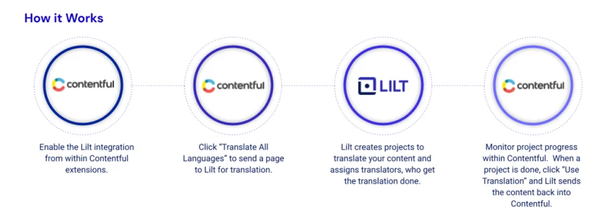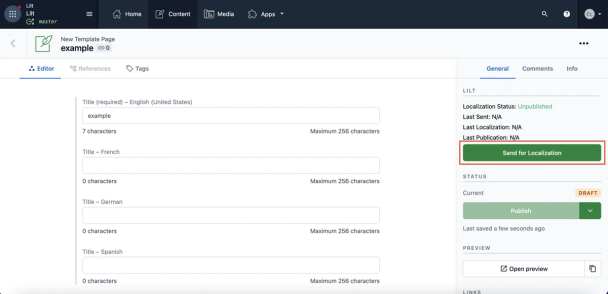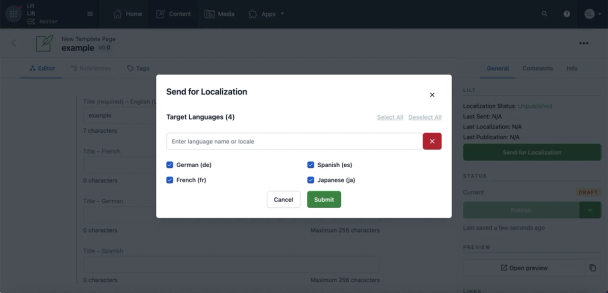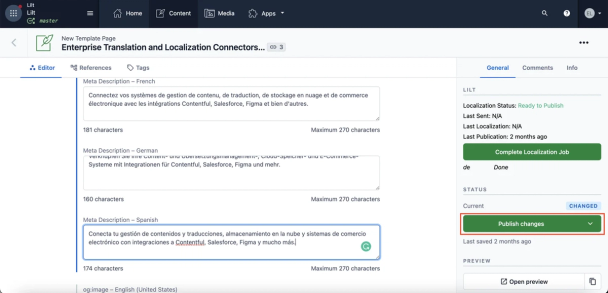10 Steps to Localize Your Website with Contentful
by

Han Mai, Associate Director, Demand Generation
·Connector
How likely are you to buy from a website that you can’t read? A study conducted by CSA Research found 87% of customers wouldn't buy from an English-only website. Consumers simply aren’t confident enough to part with their money on a website in a language they can’t understand. From eCommerce websites to cryptocurrency transactions, reaching customers in their native languages is essential for building trust. And while 70% of professionals agree that their website is critical to company success, only 60% believe that their websites are being effectively localized for global customers.
So what does this mean for the customer? Many are forced to experience fragmented, incomplete website experiences that aren’t available in their preferred languages. Oftentimes, this simply leads customers to shop elsewhere.
Your website is typically the first digital experience your client has with your brand, and delivering an exceptional experience is what convinces them to engage. That said, there are a number of challenges to be aware of when it comes to streamlining workflows, ensuring high quality, and identifying the right stakeholders to collaborate with.
The good news? Integrations can help! With a few clicks of a button, you and anyone on your team can send, review, and publish translated content from within your instance. In this blog post, we’ll be simplifying the website localization process with LILT’s Contentful Connector into 10 steps.
Here’s how to get started.
Step 1: Identify Target Languages and Markets
Before you get started on localization, you’ll want to identify which languages or markets you want to target. While there are a number of different ways to think about your language strategy, we recommend targeting locales that present the most opportunity for revenue.
Below are a few factors to consider when identifying locales with high revenue potential:
• Prospect country: Where are your current leads coming from?
• Website traffic: Where is your website getting the most visitors/traffic from?
• Total Addressable Market (TAM): What languages/countries will yield the highest return of revenue for your company?
•Third-party research: Is there data to support your language expansion plan? An example of third-party research is CSA Research’s report on top global languages, which is based on the online digital opportunity each language presents.
Keep in mind that a locale is influenced by language, culture, and location. For example, if you’re interested in marketing to Canada, you’ll have to consider both English and French speakers and understand any regional language and culture differences.
Pro tip: Use a platform like Google Analytics to track inbound website traffic and look at trends over time to strategize where you might need to prioritize next.
Step 2: Set a Budget and Timeline
Setting a budget and timeline ensures that you’re able to meet important deadlines without overspending. Depending on who your localization vendor is or what technologies you’re using, prices may vary between languages, linguists, or even content types.
If saving time, money, and resources are your top priorities, our Contentful Connector is your best solution. With verified translation, our linguists are equipped with translation memories (TMs) and AI to translate your Contentful content faster, more accurately, and cost-efficiently—all without a loss in quality.
Step 3: Build Your Team
Localizing your website is no easy feat. You and your team members will need to dedicate time and resources to localizing a full end-to-end website experience. And in order to make sure that there are no gaps in your website experience, collaboration between your product, marketing, engineering, and legal teams is a must. Assigning clear owners and responsibilities is key to making sure your website has a complete and cohesive global experience.
Common touchpoints within websites are:
• Website pages
• Blog posts
• Landing pages for gated resources or demo requests
• Knowledge bases
• Privacy pages
• Contact forms
• Customer support materials
• Product reviews and documentation
• Customer testimonials
Your localization vendor should also function as an extension of your team. Ideally, your vendor will assign:
• A designated production specialist to help you manage translation progress, assign linguists to your content request, and help you stay on top of your budget, timelines, and priorities.
• A solutions engineer to help with technical onboarding and identify the best workflow for your team with the Connector.
• A locale specialist to help you navigate the nuances of each region/country.
Step 4: Set Up Workflows and Processes
Needless to say, localizing an entire website is no easy feat. However, Connectors/integrations do make it easier.
Using the Contentful Connector, you can easily send requests, review translations, and hit publish without ever leaving Contentful. You can even set up automatic translations so you don't have to worry about sending new content to translate. Our Connector provides streamlined, efficient access to high-quality translation on demand, enabling quicker turnaround times, higher cost savings, and reduced opportunity for manual errors.

And with so many teams and stakeholders in the play, we recommend setting up recurring team check-ins aligned with your project plan and content calendar. During these meetings, you should cover important topics such as current spending, shifting priorities, and any blockers from other teams.
Step 5: Send Content for Translation
Now that you’re ready to send in content for translation, let’s get started! Simply select untranslated content within Contentful and click “Send for Localization”. From there, you can select which languages you want translations for. Keep track of progress or cancel localization requests at any time.



Step 6: Preview Translations on a Staging Site
Set up a staging site where you can see translated content in the format before publishing. This is the time to spot any formatting errors or gaps before publishing to your wider audience. This step is critical to thoroughly reviewing your content and making any modifications as needed.
Step 7: Share Staging Site for Linguists to Review
Now that your translations and content are available for previewing, you’ll want to send it in for review or Linguistic Quality Assurance (LQA).
Assign linguists to go through and click around your website as any global customer would. Below are the most common mistakes to keep an eye out for:
• Linguistic mistakes and inconsistencies: this can include inconsistent terminologies, capitalizations, or awkward phrasing.
• Aesthetic issues: this can include changes to text formatting or visual design.
• Functional issues: this can include broken or misdirected links to other languages.
Step 8: Publish Translations and Website
Congratulations! You’re ready to publish your localized website. Simply go through your content and click “Publish changes”.

Step 9: Continuously Make Content Updates
Maintaining your website ensures that your global customers have access to the latest content, messaging, promotions, and more. Having a clear request process for ongoing content, such as blog posts, makes website upkeep easier, faster, and streamlined. Consider creating a website update form, with deadlines, priority levels, and status updates, for team members to fill out.
For all new content, repeat steps 5-8 in your target languages.
Pro tip: As a general rule of thumb, consider localization early in your content development and writing process. Rebuilding your existing workflows to proactively bring in localization early into the process — and not as an afterthought — allows you to create up-to-date content that considers all languages and customers.
Step 10: Test, Measure, and Refine Your Localization Workflows
Success looks different for each team and business. Nailing down both directional and bottom-line metrics will make sure that you’re on the right path to achieving your global goals and priorities. When it comes to measuring the success of your localized website, there are several success metrics to consider:
• Sales in your target location
• SEO ranking
• Marketshare
• Pageviews and conversion in a given language
Keeping track of your localization ROI and proving the value of your global experience campaign will also help you build a compelling case for future opportunities in global expansion.
Great localization processes and strategies take the time to analyze their current workflows for optimizations. If you find yourself asking where you’re spending too much, looking to cut back, or ready to find shortcuts to reduce future spending, it may be time to do a pulse check on your current localization program to identify opportunities to maximize the ROI of resources, eliminate inefficiencies, and run a lean team.
Download this eBook and get access to ways to save during the localization process
Watch our demo video to learn more about LILT’s Contentful Connector: